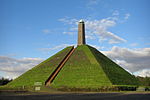Maarn railway station
Pages with no open date in Infobox stationRailway stations in Utrecht (province)Railway stations in the Netherlands opened in 1845Railway stations on the RhijnspoorwegRailway stations on the Veenendaallijn ... and 2 more
Railway stations opened in 1845Utrechtse Heuvelrug

Maarn is a railway station in the centre of Maarn, Netherlands, next to the A12. The station opened on 15 March 1845 and is located on the Amsterdam–Arnhem railway. The services are operated by Nederlandse Spoorwegen. The station was moved 1 km east in 1972, and in 2005 had approximately 1,590 passengers per day. Several kilometres further the Kesteren–Amersfoort railway branches off to Veenendaal and Rhenen.
Excerpt from the Wikipedia article Maarn railway station (License: CC BY-SA 3.0, Authors, Images).Maarn railway station
A12, Utrechtse Heuvelrug
Geographical coordinates (GPS) Address Nearby Places Show on map
Geographical coordinates (GPS)
| Latitude | Longitude |
|---|---|
| N 52.064166666667 ° | E 5.3697222222222 ° |
Address
Maarn
A12
3951 BE Utrechtse Heuvelrug
Utrecht, Netherlands
Open on Google Maps









